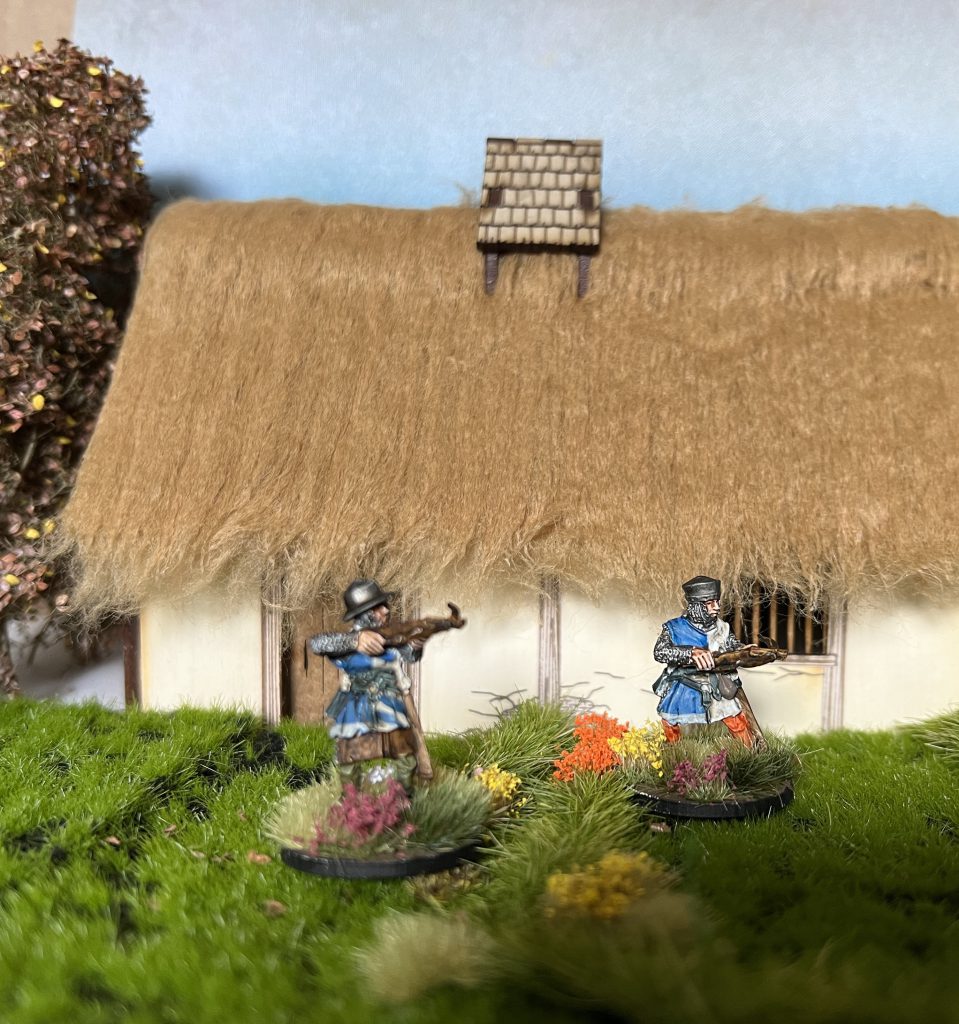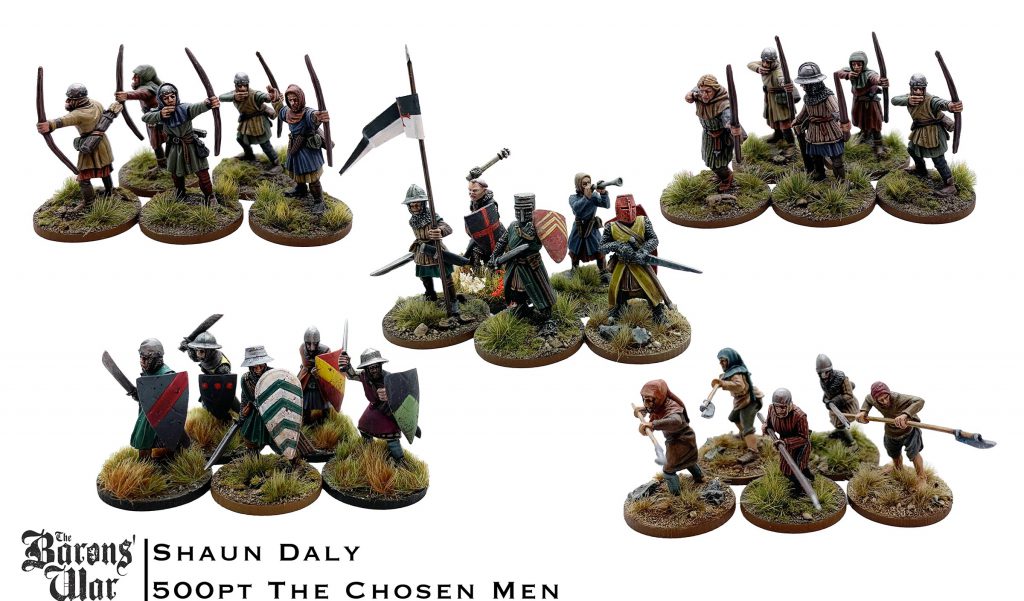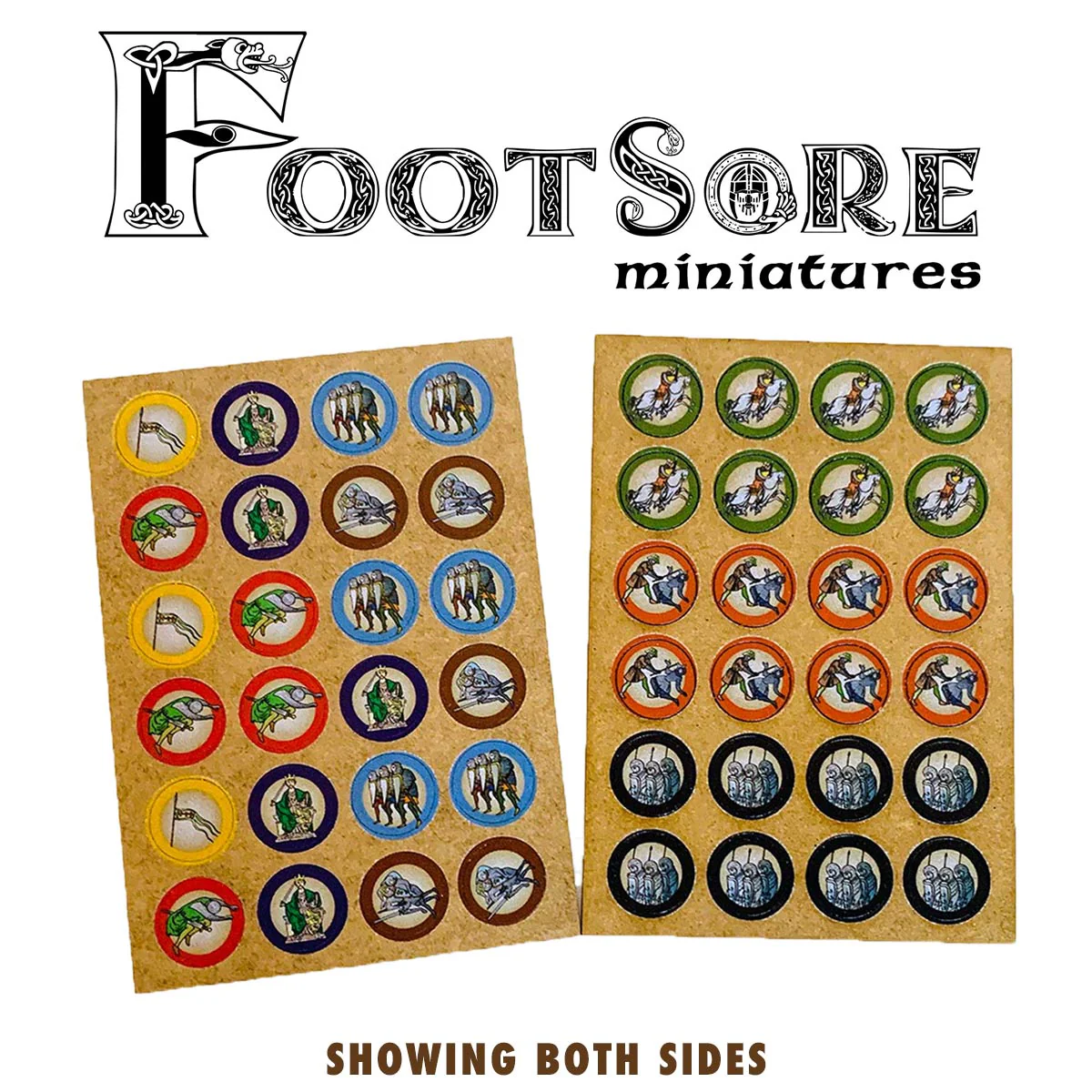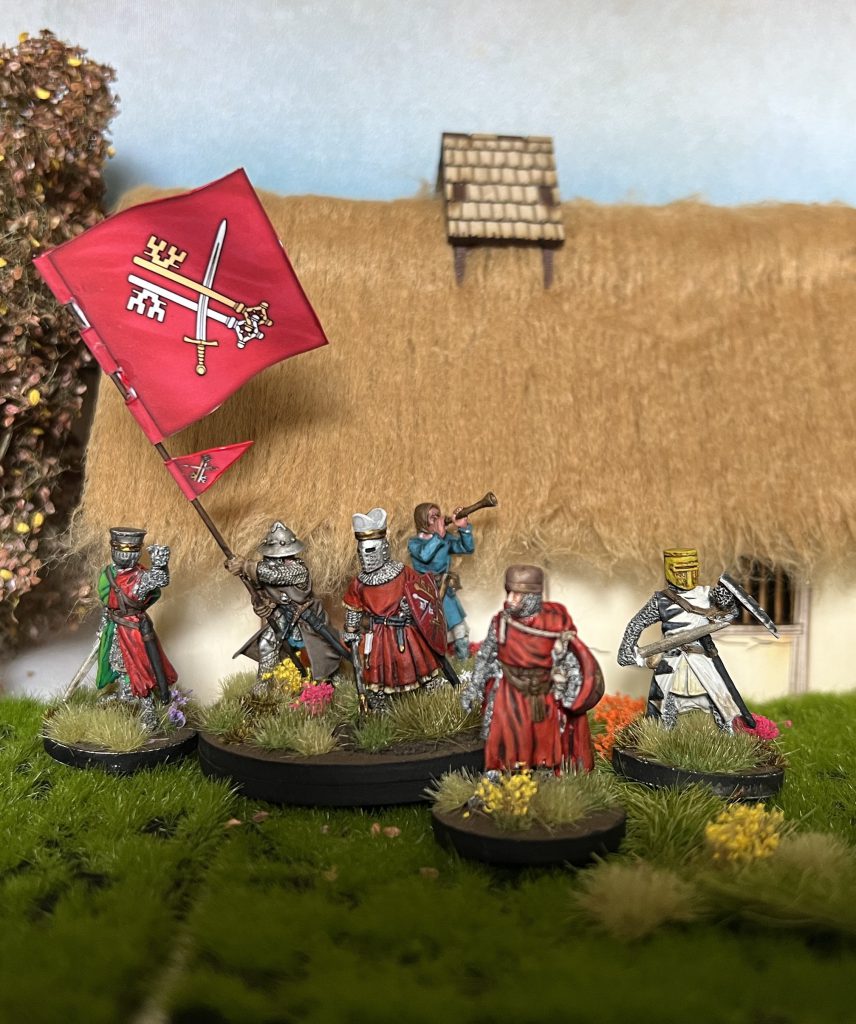The Barons’ War is a high medieval skirmish game from Footsore Miniatures. It’s been out a while and is a firm favourite in the historicals community, winning the Wargames Illustrated Best New Rules award in 2021 and filling out packed narrative/competitive events across the UK. It’s a new ruleset to me, though – as much as I’d picked lovingly through Footsores’ Miniatures range, I’d never picked up the game. With Saga Summer in full swing, and new plastic miniatures coming out for the game, my thoughts turned to 13th century England and the Barons’ War.
Before we dive into this review, I want to thank Footsore for sending over the Rules and Tokens.

Bits of the Barons’ Wars are a fairly well known bit of British History – the signing of (and refusal to honour) the Magna Carta, the perfidious King John, even Robin Hood and his Merrie Men (kind of). The details and the gaming potential might not be so familiar. Footsores’ Barons’ War puts you firmly into the skirmishes, running battles and tax raids of a short, dirty and vicious war that split England, saw the last serious French invasion and disturbed the delicate balance of peace/constant raiding across Welsh and Scottish borders. The base Barons’ War game covers the chaos of the First Barons’ War, with rules for High Medieval skirmish gaming and an army list flexible enough for forces of the King, Barons, French, Scottish and Welsh.
Why Play Barons’ War?
The Barons’ War is a fast, “true” skirmish game where you’re expecting to put somewhere between 15-40 models on the table, fighting over dense terrain with rules that encourage emergent narrative and investment in “your guys.” You’re playing warring bands of soldiers fighting the Barons’ war, from heavily armoured, mounted knights strapped to the teeth and bristling with weapons through professional sergeantry, mercenaries and Templars, to outlaw bands striking with longbow and quarterstaff from the fringes of the forest.
Models are organised and act in groups, with an activation system that rewards fast but tactical play. Your warriors act (or react) in an alternating activation system (I do a unit, you do a unit) that provides a good balance and list building choice between large, powerful units and multiple activation opportunities. The core rules are very quick to pick up and play, with a limited number of actions possible (usually one choice per unit – move, fight, defend or use an ability) and they’re all simple to work out. Dice rolls against a target number work for shooting, combat, defence and shield, with clear examples, flow charts and diagrams to take you through the processes. Speed of play and speed to learn is a pretty great advantage of the system, as with a quick read through you’ll be able to pick up 90% of the rules of the game, with no additional meta-layer (like Saga’s dice and abilities) to add additional complexity. My test games (as in the ESR case, a sadly un-photogenic affair of 2ps Vs 10ps) went from a first tentative test to a full blown skirmish in an hour or so, and I’m a classic “rules are hard” player.

Speed isn’t the only thing at play here, because a solid basic set of rules allows for Footsore to design a huge amount of depth to the game should you want to dive into it. A lot of this is in Army building. More than any other historical I’ve played, Barons’ War is “Your Guys: The Game,” with a phenomenal amount of flexibility and options to play around with to build your force. With a single list standing in for all forces at play in the First Barons’ War, you can get building lists quickly and they’ll do work. But! Take your time and dive in headlong – nine units with a plethora of experience levels, weapon options, equipment, point-buyable abilities, several different kinds of commander and a system to generate your own dramatis personae make for a massive range of potential variation in forces. You can really go down a thematic route in whatever direction you choose and I strongly suggest watching, reading or listening to some histories of the period to get you list building. I like the idea of doing a mercenary band with lots of sergeants who are taking the whole thing immensely seriously, but the options are pretty much limitless – all knights? Robin Hood? Peasant horde? All there for you, if you want them.

These unit and ability choices are supported by the D10 based system the game uses, where attacks, defence, shielding etc etc rolls are made using a D10 to hit a target number for a success. That gives a lot of options for making unit profiles distinct, and frees up some of the design space that’s often compressed in D6 based games. Allowing for a couple of extra notches on the stat belt, as it were, lets The Barons’ War differentiate Knights, Levy, Sergeants and Lords while still giving a huge range of levers to tweak with abilities and weapons. It’s a simple thing but it makes a big difference, and got me wondering why so many games shackle themselves to the limited range of options a six sided dice offers. As you can see on the Mounted Knight example below, it also allows for meaningful differences between experience levels of troops – all the options you can fiddle with for building Your Guys seem to be meaningful and important, though only time and a lot of play would be able to tell if the myriad extras and abilities are all balanced!

I think this flexibility in building your list is a big part of the narrative-enabling that Barons’ War promises, but it’s also there in the provided scenarios which largely present objective-driven options with 12 accompanying deployment maps, some of which are very different to your standard line up and slog it out game. It’s going to be a fun game to play in a one-off, but it’s going to really shine with regular opponents as you fight over some godforsaken village for the prize of collecting taxes off oppressed peasants, or alternatively, play the villagers trying to hold on to what’s theirs! There aren’t any campaign rules in this book, but look out for our next review – Death and Taxes, a campaign focused expansion to the core rules.
The Tyranny of King John
There are a few issues that came up in a read and test play that are worth talking about. None of them are dealbreakers by any means – and I really do recommend getting this out on the table – but good to be aware of when you’re playing.

The first is morale and statuses – for a fast play ruleset, there are quite a few tokens and dice to keep track of that denote different statuses. Action tokens make a lot of sense to denote when a group has acted (as opposed to saving their action for a reaction), but on top of that you have Weary (done too much too quickly), Broken (running), Shocked (hunkered down), Defending (shields up) and similar abilities (Brace for spears, for instance) and trailing units, the Morale Dice which affects their static target score for morale checks. The Footsore Token set (also sent over by Footsore) are very nice and do help with this, but there’s a lot of tokens hanging around for a small scale skirmish game. When I head out and play this more, I think some kind of token holder per unit would be handy, otherwise there’s a lot of information left on the table.
The variation possible in the list building can also affect speed of play. As equipment is bought per warrior in a group, I think (couldn’t quite work this out) every model in a unit can have different weapons – if so, this can really slow down the game as you work out what attacks have the falcion rule, which are with two handed weapons, which have maces (which are worth a mention for the weirdly versimilitude-testing rules that accompany them), who gets an additional shield roll, etc etc. If you want to go fully varied per model, you’re likely to really slow down the game. Making a unit of Knights, each with their own speciality weapon is undeniably really cool, but playing with that unit is going to take twice as long as playing with one with a single set of equipment.
EDIT: The FAQ clarifies that all warriors in a group must have the same equipment, so please ignore this point – fast play it is! Hopefully if there’s another edition this will be very clear in the main rules.

The final thing is one of the eternal bugbears of Historicals games and that’s rules layout. There’s some odd choices as to where core rules are put, like abilities are split into point-buy and inherent (but stat blocks for units don’t tell you which is which), Morale-related checks are split across several sections, and the rules for Command appear in the middle of the army lists. On a first read this was a little confusing, but at least compared to many other books on a second read it all made sense.
Looking Lovely, My Liege
I don’t usually remark on how good a game is going to look on the table, because that’s really up to you, not the designers, but I think Barons’ War is going to look GREAT. This is a terrain-dense game, with the recommendation of one piece of either simple line of sight blocking terrain or something like a building or forest per square foot of board. The “standard” board size is 3×4, so you’re looking at 12 pieces of terrain. The rules are (as with the rest of the game) quick and simple, so expect your games to be intense affairs of ambush and killing fields, Knights storming churches and bowmen hanging out in woods. Shooting is pretty lethal in The Barons’ War, either in extreme long range sniping from longbows or terrifying short-range armour piercing with crossbows, so you need that terrain on the table. With it, and with the rules pushing fully what-you-see-is-what-you-get “your guys” you’re going to be drawn into a beautiful, thematic, period-accurate-feeling game where play is tense, tactical and fast and that’s got a beauty all of it’s own.

So after all that, should you give The Barons’ War a go? Yes. If you’re here because you’ve enjoyed our SAGA content, this is a very different kind of game, but just as fast and just as enjoyable. Taking a very different approach from the undeniably gamey SAGA and much more in depth than Lion Rampant, the Barons’ War will put you firmly in the mud, fields and villages of early 13th century England, there to win glory, freedom, money or revenge with a hardy band of soldiers you’ve picked, trained and equipped to your vision. Go check it out at Footsore Miniatures – I think you’ll enjoy it!
Have any questions or feedback? Drop us a note in the comments below or email us at contact@goonhammer.com. Want articles like this linked in your inbox every Monday morning? Sign up for our newsletter. And don’t forget that you can support us on Patreon for backer rewards like early video content, Administratum access, an ad-free experience on our website and more.


